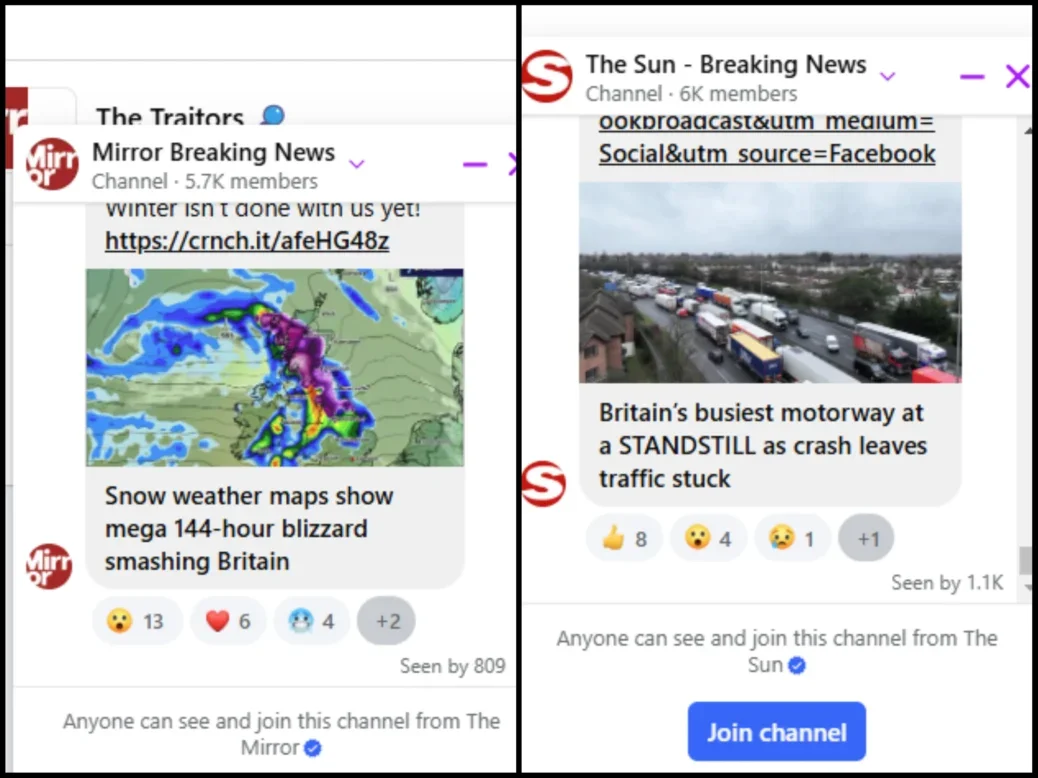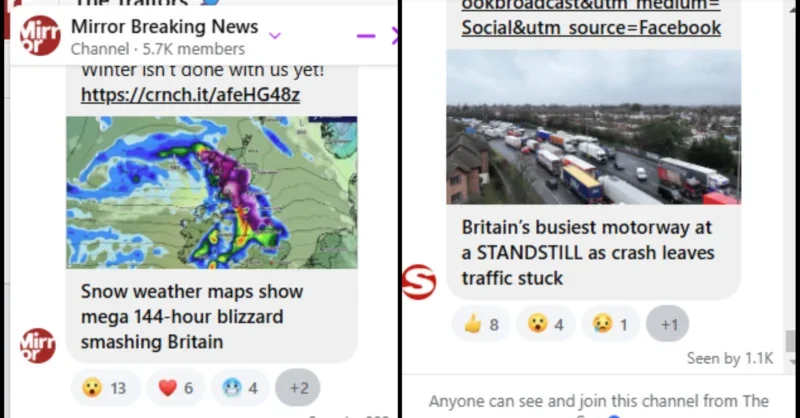
Facebook Channels is following in the footsteps of Whatsapp Channels as a new way for new publishers to use direct messaging as a way of distributing content.
Facebook Channels allows publishers to create a Messenger feed through which they can post links, polls and other messages to followers of the chat.
People who have joined the channel see messages in their main feed alongside updates from Facebook contacts and can react with emojis and vote in polls, but can’t post to the feed themselves.
Facebook describes these “broadcast channels” as a “public one-to-many messaging tool for creators to send content directly to followers in a chat format.
“This tool allows you to engage more deeply with your most loyal followers in an authentic space.”
Channels became available to pages with more than 10,000 followers in June and subsequently also rolled out to profiles of creators with professional mode turned on and the same minimum following.
Several of the UK’s biggest publishers are trying out Facebook Channels as a way to engage with readers and boost traffic referrals back to their websites.
Many are focused on breaking news but the chats can also be used to distribute news on a specific topic like showbiz or sport.
The Daily Mail has the biggest Facebook Channel by followers (30,100) out of the pages viewed by Press Gazette, but has not posted in the feed since 10 January.
Meanwhile, The Independent joined this month with a breaking news channel that has 12,100 members so far.
Reach: Facebook Channels ‘do drive page views’ despite slow growth
Reach, which began trying out Facebook Channels at some of its brands in September, has 120,000 members across 50 channels.
Dan Russell, audience and content director (social media and off platform) at Reach, told Press Gazette the publisher does not have a “fully-fleshed strategy” for the channels but is trying things out and seeing slow and steady growth so far.
He said: “They do drive page views, they do drive referrals, and a little bit like Whatsapp, the more you grow it, the more you get from it.”
Facebook groups and Facebook Stories still have better results, he said, “but it’s definitely part of our mix”.
Russell noted that each of the 120,000 people subscribed to a Facebook Channel could be someone the publisher might not have reached otherwise. Even though they use Facebook, he said, they might primarily use the platform for its videos feed rather than the main text and images-based feed, meaning they may not otherwise see links shared.
Reach website My London has nine Facebook Channels, including for updates about breaking news, the London Underground, and East, North and West London respectively.
Russell said there may be some relevant stories shared on more than one of the channels but there does not appear to be that much crossover in members as people choose what to join based on their specific interests.
Whatsapp Channels, a similar function in Meta’s sister messaging app that allows publishers to send article links to any users who subscribe to their feed, launched in 2023. Whatsapp also has Communities, which enable publishers to interact with readers more closely by setting up groups, limited to 2,000 members, in a more visible section of the app.
Reach has since received four million traffic referrals from Whatsapp and had a record-breaking month on the platform in January.
Meanwhile Instagram Channels were rolled out in the UK in September 2023 but currently appear less utilised by publishers than Meta’s other similar services. If a publisher has an Instagram Channel, it can be found via a link at the bottom of their bio at the top of their profile, next to their Threads handle (if they have one).
Russell said Facebook Channels have been “more successful than the Instagram ones but nowhere near as successful as Whatsapp” for Reach.
He said there has to be a decision-making process of “we’ve got this piece of content, is it right for the channel? Because you don’t want to bombard people in the channel with it, or you don’t want to put the wrong content in there.”
He added: “We’ve got this dedicated audience in this one place – what do they want and when do they want it?”
With Whatsapp Channels, updates can be successfully sent at any time “as long as the quality is good” because people can see the notifications appear on their phone.
But with Facebook, people have to already be in the app or website to get that notification, Russell said, which means posting at peak times like evenings can be particularly advantageous. However he noted this is still a point of experimentation and breaking news nonetheless goes out when it’s relevant.
An even tricker question, Russell suggested, is how to promote the channels amid a constant need to prioritise: “If you can grow one thing, do you grow a newsletter? Do you grow a Facebook group? Do you grow a Whatsapp community? Do you grow a WhatsApp Channel? Do you grow an Instagram channel? Do you grow a Facebook? Do you grow your Threads account? Which one’s got the most longer-term value?”
One advantage with Facebook is that followers of a page who have their notifications turned on will get one saying the page has created a channel, suggesting they might want to sign up. A publisher can also write comments on a relevant post directing people towards a channel.
This may be why Instagram has been less successful, Russell suggested: “I think over time, people have got used to Facebook notifications… I don’t think you get that as much on Instagram. So it’s okay, but it doesn’t fit as naturally with the audience and we’ve had much better success with ‘link in bio’ and Instagram Stories than we have with Channels.”
Overall, Russell said of Facebook Channels: “If they deleted it tomorrow, would we have an inquest over it? Probably not, but if it’s an opportunity for us, we’ll be there and try and grow it.”
The Sun: Facebook Channels fit into drive for direct, loyal audiences
The Sun has two Facebook Channels: one for breaking news on its main page (with 6,000 members), and one for football news on The Sun Football (3,800).
Head of audience Phil Harman told Press Gazette that although the numbers are currently small, they drive a “decent amount of traffic” proportionally and a more loyal audience.
Harman said this fits into The Sun’s big focus right now of building its direct audience – as demonstrated by its launch this month of a paid membership/partial paywall on its website.
He added that the newsbrand wants to “reach audiences where they are” and that the channels allow publishers to “talk to an audience directly” at a time when Facebook’s main feed has become centred around its recommendation engine (although this can still drive big reach).
Despite the downward trend in Facebook traffic over the past two years, Harman revealed The Sun has overall seen positive signs on the platform recently with referral traffic up 150% this month compared to November.
As part of its wider video strategy The Sun has also built a “positive and growing area” within Facebook video with revenue up.
Meanwhile The Sun has 12 Whatsapp Channels including several niche sport ones for Cristiano Ronaldo, Manchester United, Arsenal and Chelsea which Harman said are “really engaged”.
The Sun’s social team considers when to put stories in Facebook Channels as part of their day-to-day routine but are keen to keep it “relatively light touch” without bombarding users, instead focusing on major breaking news and Sun exclusives. Harman compared this strategy to choosing which stories will get push notifications on the web.
Overall, he said: “It’s a smaller audience, obviously, it’s not going to significantly change our day-to-day traffic, but that focus on direct audiences is still positive for us.”
Email pged@pressgazette.co.uk to point out mistakes, provide story tips or send in a letter for publication on our “Letters Page” blog
This article was originally published by a pressgazette.co.uk . Read the Original article here. .

